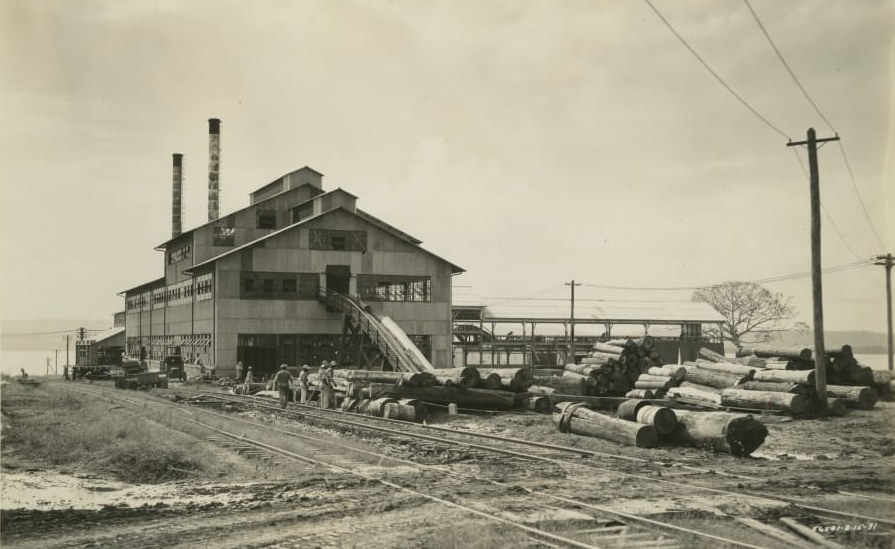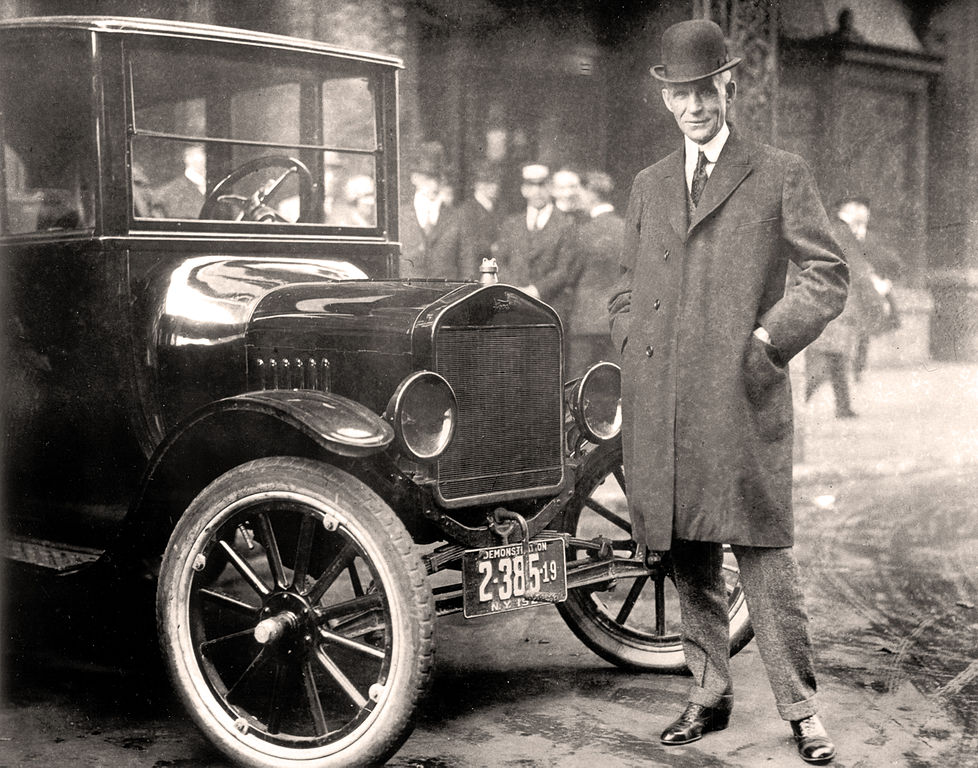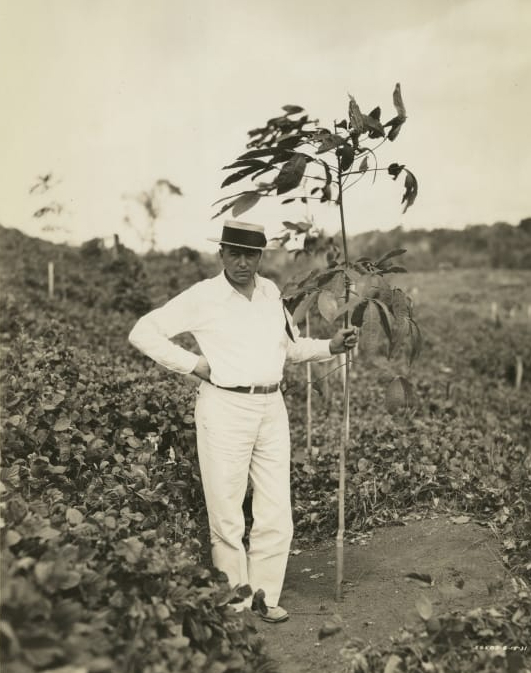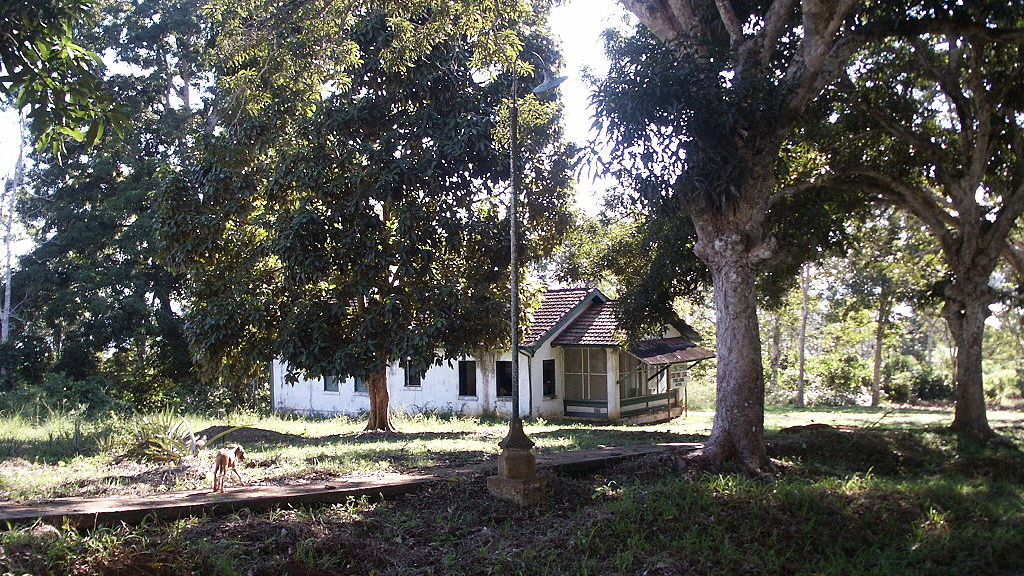He was one of America's greatest innovators, but his plan to build a production city in the Amazon ultimately ended in disaster.
-
Winter 2022
Volume67Issue1
Editor's Note: Mark Callaghan is an art historian who has taught at several leading institutions, including Birkbeck College and the University of London. He specializes in contemporary memory culture and 20th-century art history and is a resident historian for Viking Cruises.

Fordlândia is a small town, with a population of 3000, surrounded by interlaced greenery, and has long been a host to several derelict buildings. It receives only a few visitors each year, but then the 16-hour journey along the Tapajos River is a test for even the most fearless traveler. A tributary of the clay-brown Amazon, the Tapajos offers bohemian villages, milk-white beaches, and screeching birds that are frustratingly elusive. But the confluence also includes rocky waters, a disappointing lack of colorful wildlife, and a tyrannical humidity. It feels airless.
The wilderness monotony is finally disrupted by the uncanny sight of an industrial object rising above the trees – a 150 foot water tower that was once the Amazon’s tallest structure, a pod that looks like an upturned bell with pointed hat, sitting on triangular stilts. Uncanny but also piteous, eroding and disused, it’s an antique, a stranger to this environment where it’s hard to imagine it ever belonged.
The forest cover is eventually broken to reveal that people still live here despite the forsaken buildings that dominate the town. A small church on the hill and humble dwellings are the first signs of residency, so too the ferry boat at the jetty. The town is enticing, with its mix of habitation, enormous disused industrial sheds, and an empty glass-walled Turbine Hall. As one gets closer to the water tower an all but faded logo appears against its white background. The blanched emblem is one of the most recognized, as the monumental tower is stamped with what remains so familiar to our eyes today – that bold signifier of accomplishment, audacity and mass production: the iconic blue oval design of the Ford logo, with white lettering, often mistaken for being its founder’s signature.
Explorers can observe the remnants of Henry Ford’s would-be (as he saw it) utopian production city, noting that equipment from the sawmill and generator was left to the elements and vandals over the years, rusting in the thick Amazon air. This is still known as Fordlândia even though the project failed and the land was sold back to Brazil in 1945. Those that complete the arduous journey along the Tapajos see what the town’s founder never did. Ford never visited, so never saw the construction of the plant, the building of houses, the opening of facilities that included a golf course and a dance hall, nor the demise of the jungle city named in his honor. Nor did Ford see the worker revolts, the fleeing American personnel, and the arrival of the Brazilian Army who restored peace.
Today’s Fordlândia has the hallmarks of a collapsed enterprise, the downfall of ambition symbolized by once-confident constructions now long decayed. Either this, or one has the impression that the dereliction is the result of arrogant desertion of production essentials after targets had been exceeded and the site exhausted of potential. But no targets were met. Not a single drop of Fordlândia latex was ever used in a Ford car.

Fordlândia was created as the brainchild of the world’s most ambitious industrialist, a man who remains as synonymous with technical innovation as Steve Jobs and Elon Musk. The scheme of tapping into Brazil’s wealth of rubber, then converting this into tires, misfired not because of misfortune or betrayal, but because of Ford himself. Despite being a good source for inspirational quotes, not to mention his progressive values concerning the workforce, Ford’s broken venture can be understood through one of his most renowned sayings: “Obstacles are those frightful things you see when you take your eyes off your goals.” Fordlândia is actually a tale of this, where obstacles were not even identified, where the goal was all that could be seen, leading to catastrophe. The death looks to have been gradual, then sudden.
Prior to the operation at Fordlândia, Ford had known only success. By the 1920s, the majority of American motorists had learned to drive using the Ford Model T, with 15 million cars manufactured by 1927. As the few surviving films and sound recordings of the automaker show, Ford had an uncanny ability to persuade and appear compelling to reporters and investors. But it was his company that had an incalculable effect on society, and he is justly remembered as the great innovator, the man who revolutionized car production, introducing the first moving assembly line and the promotion of the five-day, forty-hour working week.
Founded in Dearborn, Michigan, in 1903, the Ford Motor Company exemplified American positivity, the ambition of the “young” country, and the rise of the mega-corporation, best cited by Ford’s advice that, “Whether you think you can, or think you can’t – you’re right.” A century ago, that same attitude caused Ford to ruminate on the resources of the Amazon basin, a vast region known for rubber production and therefore ripe for a plantation that would serve the Ford Motor Company’s high demand for tires. Brazil had lost its monopoly on global rubber production, and with Ford concerned about rising costs in the newly dominant Far East, the prospect of having his own supply made him follow his can-do advice.
The venture would not entirely be motivated by business interests, though. Ford was equally fascinated by the Amazon (after being told of it by his friend and ex-president Theodore Roosevelt), as well as the idea of building a city dedicated to manufacturing, with all aspects of the metropolis geared toward creating the ideal life that would make for super-efficient production. The prospect was also intended to benefit the economically ravaged Amazon region, creating 10,000 jobs. Ford even went so far as to declare: “We are not going to South America to make money, but to help develop that wonderful and fertile land.”
There was much at stake for Brazil. Once a titan of the rubber trade, the country was desperate to revive its strong association with a commodity it made famous. Employment for local Brazilians was one thing, but being an essential supplier for the world’s leading car manufacturer could rejuvenate so much of what Brazil had lost, renewing its status through affiliation. The Amazon’s decline began, famously, in 1908, when British explorer Henry Wickham smuggled 70,000 Pará tree seeds to British territories in Sri Lanka, Malaysia, and Indonesia, where they thrived in tropical environments and where no infestations and pests affected production. By 1920, a region associated with “latex lords” – including the thriving port of Belem, and upriver, the lavish Opera House of Manaus – was eroding toward dereliction. British colonial plantations, arranged in dense rows, outperformed Brazil’s less organized rubber-tappers, leading to market dominance in east Asia, while Brazil could only observe the decay of former glories, symbolized in its once opulent mansions now neglected, and Europe’s finest opera singers unwilling or no longer able to afford to travel deep into the rainforest.

But the Amazon’s disarray was Ford’s opportunity. Or at least it should have been.
By 1926, negotiations began that led to Ford obtaining a concession from the Brazilian government for a tract of land – about the size of Tennessee – on the Tapajos, which joins the Amazon at Santarem, in exchange for nine percent of the profits generated. Ford’s goal was not solely motivated by the shipping of latex back to his assembly lines in Michigan. It was the creation of an entire city, Fordlândia, officially Companhia Ford Industrial do Brasil. Ford invested fortunes (eventually totaling $20 million), with a goal of producing 38,000 tons of rubber to supply almost 2 million cars a year.
In the Amazon, Ford applied the organizing principles that made the Ford Motor Company into such a bastion of efficiency. In fact, the doctrine was not only applied to the Amazon project, it was expanded. As Greg Grandin outlines in Fordlândia: The Rise and Fall of Henry Ford’s Forgotten Jungle City, “Fordlândia represents in crystalline the utopianism that powered Fordism – and by extension Americanism”. Under the management of Norwegian-born Einar Oxholm, Fordlândia was laid out with a basic street grid, with pleasing names like Riverside Avenue, Boa Vista, and for American employees, the separate neighborhood of Vila Americana, complete with Cape Cod-style bungalows.
Fordlândia was, in many ways, a socially engineered replica of small-town America, which also featured schools, a hospital, generators, and the monumental water tower. Because Ford was a teetotal vegetarian, the “civilizing” project also included a meat-free diet and the prohibition of alcohol, with the provision of worker’s cafés, shops, a swimming pool, the promotion of line dancing, and an eight-hour working day. Acclaimed for the good treatment of his employees (20% of his Michigan workforce had some form of disability), Ford’s ethos was replicated in the Amazon, with Fordlândia paying its Brazilian workers a handsome rate for the region, plus access to free quality healthcare, food, and education for their children – a package that was unthinkable for other citizens of the Amazon basin.
This does, on the face of it, sound like a blueprint for an environment conducive to high productivity and contentment. Surely there would be scant cause for complaint in this new town that offered so much. And yet the paint on the water tower’s Ford logo was barely dry before Brazilian workers began to riot.
Ford’s first mistake was his plan’s cultural insensitivity. As the National Public Radio reported, despite the utopian spirit, the “first failure of Fordlândia was social.” Whether it was jingoistic arrogance or simply ignorance, Ford and his managers paid no attention to Brazilian working practices, expecting laborers to comply with a nine-to-five schedule when they were used to avoiding the hottest parts of the day. The opportunities for leisure and education were generally appreciated but there was vexation among the Brazilian workforce who felt they were being pushed to attend poetry readings and English-language-only singing lessons. Already resentful of enforced vegetarianism and the forbidding of alcohol (which remained lawful in Brazil), some Brazilian employees were quick to create a bar on a small island known as “The Island of Innocence.” Here they enjoyed a respite from Ford’s dietary and consumption regulations.
And while this clandestine islet was a speakeasy that subdued insurgency, discontent between the Brazilian workforce and American personnel worsened. This was stimulated by Vila Americana being the only suburb with running water, plus the separation of skilled and manual workers in canteens, the enforced wearing of ID badges, and then by a Ford engineer’s decision to change food service from restaurant to cafeteria-style (it was calculated to be more efficient). Laborers vandalized parts of the city, including the time clocks they so resented. They damaged generators and manufacturing equipment, causing administrators to flee by boat until the violence was quelled by the Brazilian military.

Ford reacted by employing a new manager, Archibald Johnston, and with more money pouring into the project, Fordlândia was rebooted with some concessions to those who had rebelled. In tandem, returning Americans were quick to inform their Brazilian counterparts that Vila Americana’s Cape Cod-style homes were hardly comfortable, as the metal-roofed houses, ideal for mid-west America, could not have been more unsuitable for the Amazon’s sweltering heat. Americans also encouraged the Brazilian workforce to consider why some wives, who had accompanied them from Michigan, were making homeward-bound preparations, unable to bear the oppressive conditions and the threat of further uprisings. So instead of creating a utopia, Ford and his managers created despondency.
But cultural discord was only one of many problems that plagued Fordlândia. While Ford, the “sociologist manufacturer”, had many good intentions, the project was hamstrung by an ironically incautious approach to repeating Michigan’s prerequisites for the rainforest, with no apparent consideration as to whether “Dearborn in the Jungle” was feasible without modifications. Specifically, Fordlândia sought to emulate the efficient plantations Britain promoted in the Far East: densely cultivated, with trees planted in compact rows. Rubber trees, however, had never been grown this way in their native Amazon basin. Pará trees were planted, based on conditions in Sri Lanka and Malaysia, without Ford even consulting a botanist who would surely have warned against the condensed plantations in the Amazon’s particular environment.
Ford’s American success had been achieved without consulting specialists. Ford was, in fact, dubious of anyone claiming to be an authority. Ford, who never visited the Amazonian city named in his honor, did not care to learn about botany or agronomy, and overruled the logical suggestion of not planting rubber trees during the hot and dry season, a decision that resulted in the deterioration of nearly all plants. Enterprising British botanists had also discovered another advantage of Asia’s tropical regions over the Amazon: plantations in the Far East were not subjected to the natural parasites that would blight Ford’s grand scheme, largely because dense plantations in Brazil only served to create an environment where sauva ants, lace bugs and red spiders – all of which naturally feed on Pará trees – would thrive.
As a result of multiple failures – both social and business – Ford’s rubber-sourcing hub ended in 1934, with no latex produced for his cars. During the early 1930s, Fordlândia was, to those who still assumed Ford was infallible, actually an example of how to survive the Depression, but the economic rationale for persisting with the project could not be justified. As Bryan R. Ford recounts in Beyond the Model T, Ford was rich and successful, but also “intractable and headstrong.” Fordlândia’s houses and factories were abandoned, and the land sold back to the Brazilian government in 1945 at considerable loss, with Ford recovering only $244,200 of his $20 million investment.
Despite the project’s breakdown, Ford’s daring would actually inspire venture capitalists, not only for his intrepidity but also because Ford was circumspect in not committing the kind of investment that could have ruined his Dearborn operations. What remains curious is Ford’s determination to press on with his scheme in the jungle without making significant changes to a plan that was failing. The failure of Fordlândia comprises a story of staggering horticultural miscalculations, a cultural mismatch where Brazilians resisted and resented mid-western Puritanism, and a belief by the project’s American management that the enterprise would ultimately flourish because Ford’s record was so extraordinary there was no reason to doubt what he could achieve. While one of the world’s most complex ecological systems ultimately prevented the venture’s success, Ford’s naïve disrespect for this same complexity, driven by hubris, could be seen as an even greater factor. Ultimately, he shunned not only his advisors but also his own advice.
After Ford’s workforce abandoned the city, Fordlândia slowly returned to the jungle, left to the elements, fated to be wrapped in vines and layers of vegetation, with equipment rusting, looters stripping what valuables they could find, and colonies of bats covering the Cape Cod-style residencies with guano. Boa Vista would continue to offer its beautiful view of the Tapajos and the seemingly infinite jungle, but all around would become dilapidated. The once modern hospital would begin to crumble and the glass-walled Turbine Hall would soon begin to corrode and would, like all structures, come to represent a monument to a vanquished affair. The blanched emblem on the water tower now stands as a metaphor of the forsaken grand project, a relic of what could have been, stamped with the insignia of a corporation – and a founder – that defeated itself.

